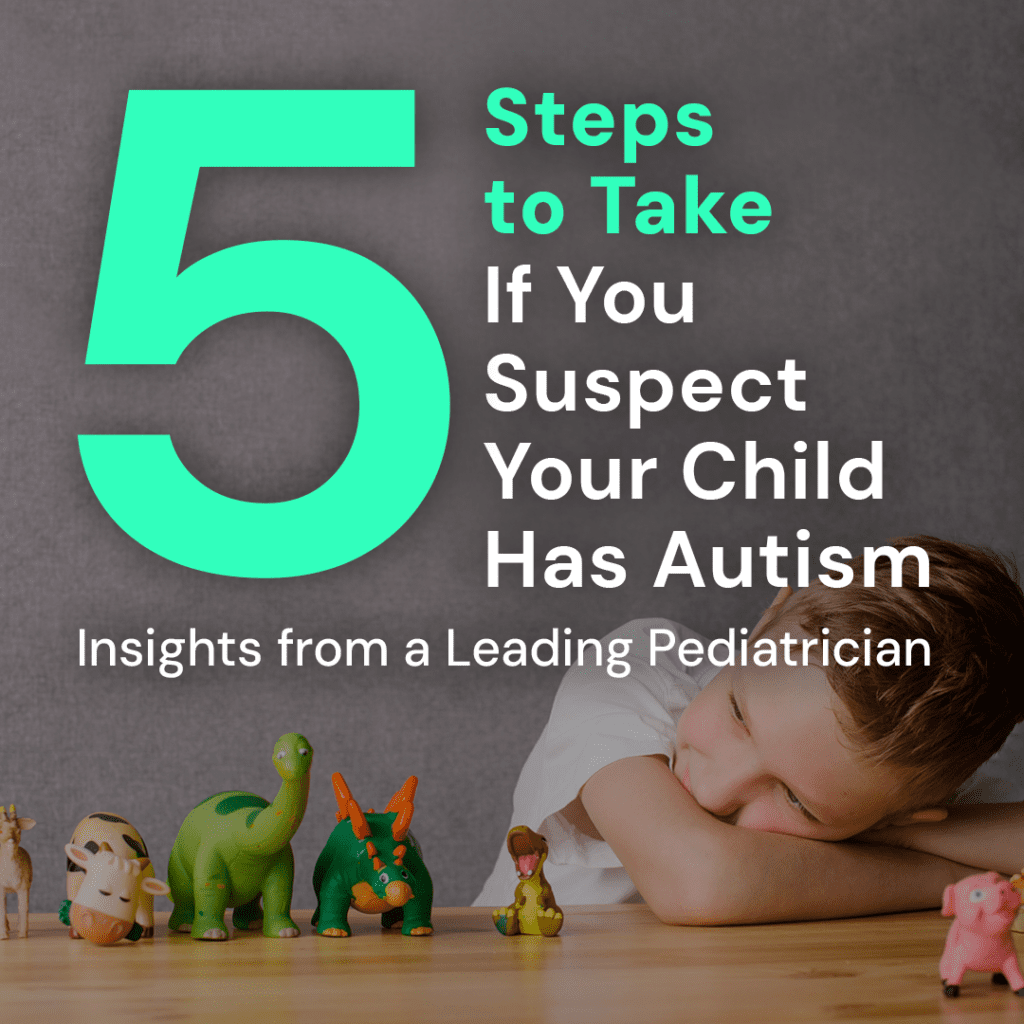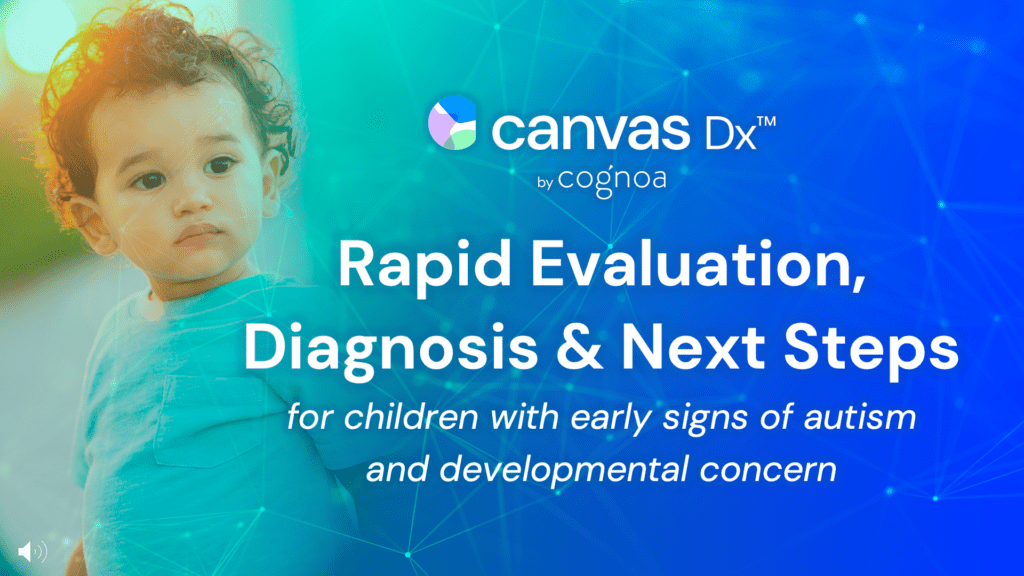Podcast: an Introduction to Artificial Intelligence and Machine Learning in Autism and Child Developmental Health

In a recent episode of the Autism Science Foundation Science Weekly Science Podcast, Cognoa founder Dr. Dennis Wall offers a helpful introduction to artificial intelligence, machine learning, and how these technologies are already at work in our daily lives and in healthcare. Listen as Dr. Wall explains it all in easy-to-understand terms: What artificial intelligence and machine learning are –– and how they are different How machine learning allows technology to learn and improve from its experience Ways that machine learning is already working to help us in our everyday lives and in modern medicine The rigorous training that Canvas Dx went through to gain FDA authorization How Canvas Dx utilizes data and analysis to generate actionable insights into a child’s developmental strengths and challenges and a highly accurate prediction of autism How machine learning-based Canvas Dx learns from thousands of cases –– more than an average doctor will ever see —- and makes evaluation and diagnosis more equitable and unbiased Why it’s important for artificial intelligence to be able to say “I don’t know” How artificial intelligence and machine learning are helping primary care clinicians make quick and confident diagnoses of children with potential developmental delays Find the podcast here and on most major podcast platforms.
AAP: Primary Care Can Make Autism Diagnosis More Equitable and Timely

A recent article in AAP News (a publication of the American Academy of Pediatrics) highlights how empowering and supporting primary care physicians to diagnose autism will help make the system more equitable for more families, allowing them to get the timely assessment, diagnosis, and care they need. The news item, from co-authors Sarabeth Broder-Fingert, M.D., M.P.H., FAAP, and Sara L. Swoboda, M.D., FAAP, both members of the AAP Council for Disabilities, explores some of the pressing reasons that we need greater primary care participation in autism diagnosis, including: Kids in some groups are being left behind: Although 1 in 36 children has autism, many kids from ethnic and racial minority groups, rural communities, and low-income households experience significant delays in being evaluated Kids are left waiting while precious time slips by: Until recently, autism was almost always evaluated and diagnosed by specialists, but with more awareness of autism, there are more cases than specialists can handle, causing massive waitlists The authors make the case that the child’s medical home is the ideal place for the diagnostic process and activation of services. Primary care clinicians have a more complete picture of the child’s health and history, and “they also may be knowledgeable about local and culturally congruent supports and services”. When more children are diagnosed and managed in their medical home, specialists will also be able to focus on the children who will benefit from their expertise the most. We at Cognoa couldn’t agree more! This is why we created Canvas Dx, a medical device specifically designed for the primary care setting that equips pediatricians and other clinicians to act early, equitably, and definitively on early developmental and behavioral concerns. Learn more about Canvas Dx here and book a meeting to learn more about how Canvas Dx can work in your practice.
It’s autism acceptance month. There’s an awful lot I don’t accept.

It’s autism acceptance month. There’s an awful lot I don’t accept. It’s autism acceptance month, a time dedicated to promoting the understanding and inclusion of individuals on the autism spectrum. As a board-certified child neurologist and the CEO of Cognoa, I believe there is still a lot of work to be done to make these two words – “autism acceptance” – truly meaningful. Acceptance can’t happen without knowledge. Knowledge rests in the hands of the healthcare system. The state of its ability to evaluate and identify autism, a complex “spectrum disorder,” is deeply flawed and biased. The accepted process is broken and is, in fact, unacceptable. I don’t accept that more than a million children are stuck on waitlists – for months or even years – to be evaluated for developmental concerns. We know that reliable autism diagnosis is possible at 18 months. We know that nearly four in ten children diagnosed with autism early have such significant improvements with early interventions that their diagnosis loses relevance by age 6. But the average age of diagnosis has remained unchanged at over 4 years since the CDC’s tracking began more than 20 years ago. We’re missing the critical neurodevelopmental window that gives individuals the best chance for optimal outcomes. Inaccessible, impractical practices It is unacceptable that parents have to fill out pages of intake forms just to get on a waitlist. It is shameful that evaluations take hours, in unfamiliar clinics, after exhausting, long car rides, often across state lines to scare specialty centers. We are denying families the chance to accept their child’s development and uniqueness because they don’t even know. Isolation vs. collaboration To my physician colleagues, stop abdicating responsibility for making a neurodevelopmental diagnosis to psychologists. Isolated psychological assessment without a medical evaluation is dangerous. A third of children with autism also have epilepsy, and vice versa. Similarly, underlying metabolic or immunological disorders can go undetected when parents solely seek psychological evaluations. It is clear: the key for comprehensive, whole-child care needs to start in the primary care medical home, the pediatrician. Unacceptable policies I reject the outdated, unresponsive policies of insurance companies and states that refuse to recognize autism diagnosis made by primary care pediatricians — a denial so egregious considering there are only 758 developmental-behavioral pediatricians in the entire U.S. to cater to the needs of 19 million children. Mandated assessments Insurers and policies that arbitrarily require specific assessments using research instruments with known biases, which are simply unusable for primary care settings, only serve as barriers. It is unequivocally known in the clinical community that these lengthy, impractical evaluations are unnecessary for many children. High cost of inaction I do not accept the self-proclaimed “innovative” insurers that procrastinate. Not when it is indisputable that early interventions can dramatically decrease the likelihood of lifetime, comorbid mental health conditions. Not when we know we can cut overall healthcare utilization and costs when children are diagnosed faster and sooner. Yet the status quo remains. Inequities I cannot accept the prevalent inequities and injustices that continue to exist. I am appalled that girls continue to be diagnosed significantly later than boys. I am dismayed that people of color are still being misdiagnosed, diagnosed years later, or missed by the “system” altogether. I’m from Detroit, a dad of girls, a volunteer for the Girl Scouts, and live and work in L.A. These inequities are offensive, and I would hope unacceptable for anyone, regardless of background. DEI lip-service Diversity, equity, and inclusion initiatives ring hollow when objective, accessible solutions exist. Diversity is crucial to truly account for differences in gender, race, ethnicity, socio-economics, and zip code. Responsible AI, built and trained on diverse data, mobilized for at-home use, used within the medical home of the family, truly embodies DEI compared to subjective, scarce, resource-intensive diagnostic processes. High time for change These facts are no exaggeration. We don’t accept this kind of procrastination for any other medical condition. If you can’t tell, I am screaming and frustrated that this is falling on ears that refuse to listen, resist change, or just don’t give a shit. The medical establishment can and must act, no excuses. Early childhood development and behavioral healthcare is a clear opportunity to decrease costs, optimize our resources, and improve quality of care, and life. Change these outdated policies and practices that contribute to the waitlist crisis rather than solve it. The American Academy of Pediatrics declared a state of emergency in youth mental health and have vowed to take action to ensure pediatricians’ diagnosis unlocks the coverage of essential services that children need. Some policy-makers are slowly standing up. Some commercial health insurers are making moves. More of them can do more, and do more faster. We can’t be afraid of change. We clinicians took an oath, “do no harm”, but we are harming our children because every day they wait for an evaluation is a lost day of profound intervention that cannot be replaced. Try and try again. Yes it’s change, but it’s necessary change that will have a real impact on the daily lives of children and their families immediately, and life-long. This April, of course I’m accepting of autism. But we must also stand for changing archaic thinking, approaches, and policies that prevent the first crucial step so that families can even begin to accept. Stand for knowing, knowing early. Demand that opportunity.
5 Steps to Take If You Suspect Your Child Has Autism: Insights from a Leading Pediatrician

So, you’re worried about some of your child’s behaviors. Maybe they are not talking or communicating the way you would expect them to at this age, or they don’t seem to understand when you talk to them. Perhaps they get extremely frustrated and have tantrums that might seem normal in a younger child, but not at their current age. You’re wondering about autism, but you may not know much about it. The idea that your child may be “on the spectrum” can cause anxiety. It can be hard, because you want to do everything possible to support your child, but you have so much to learn and may not have the slightest idea where to start. I have been a practicing pediatrician for over 35 years, and I’m a past President of the American Academy of Pediatrics. I have seen a lot of children and families, including many families of children with autism. And I have good news for you! There are plenty of resources available to support your child. Here are five clear steps you can take when you begin to suspect your child may have autism – even before you get a diagnosis. Step 1: The traits that often go along with autism can be noticeable quite early on (so if you DO notice something, trust your instincts) It is crucial to trust yourself. Some traits of autism are noticed by parents as early as fourteen to eighteen months. There is NOT a single trait that means your child has autism. Difficulty in communication is a common sign. If your child doesn’t respond to their name, or isn’t pointing and doesn’t bring items for you to look at with them, this may be concerning. Children who are unable to express their needs might have increasing tantrum behavior around this age, and while that can be typical toddler behavior, it can also be an early sign that your child is on the autism spectrum. Share behaviors and what you’re noticing with your pediatrician. Pediatricians today are better equipped than ever to act early on developmental and behavioral concerns. There are fast and easy assessments available in primary care – like Canvas Dx. Step 2: Even if your pediatrician suggests a “wait and see” approach, you can take control of your child’s care on your own through Early Intervention One of the areas in which I’m a big advocate is working with healthcare professionals on how to connect families with intervention services earlier, even before an evaluation. In addition to talking with your pediatrician, the next call you should make is to your local Early Intervention program. Every county in every state has an early intervention program for children under three years old. You don’t need a medical professional to refer you. Parents are free to call to request the appropriate evaluations for their child and set up an individual family services plan, which is also called an IFSP. Getting your child into an early intervention program will help your child through their preschool years and give them a firm foundation for starting school. Step 3: Look for a Help Me Grow program in your area Many communities, children’s hospitals, and other organizations have programs called Help Me Grow. It is a program that looks at the whole “spectrum” of child development, including behaviors, and points out potential developmental concerns. These programs can often be a very great resource for you. You don’t need a referral for you to call them. Help Me Grow programs are not available in all fifty states, but families with access to their services should seek them out. Step 4: If your child is older, you can still get the ball rolling through your school system If a child is over three years old, they are part of the school system. Prior to the 1970s, when a child had autism or a severe medical condition, they didn’t go to school. However, child advocates fought to expand educational access, which led to the development of the Individuals with Disabilities Education Act (IDEA). Now all children from ages 3 through 21 are entitled to a free and appropriate education. Because your child is entitled to that education, you have rights. If you feel strongly that your child is on the spectrum and needs special education services, it is incredibly important to request them in a specific way: Write a letter requesting a “Child Study.” It is essential that you say “Child Study” in your letter, and you need to sign and date it. “Child Study” is the legal language that tells the school, “You have two weeks to respond, and you have 60 days to get a child evaluation on the books.” This evaluation is crucial for getting your child into the special education system, with access to helpful programs and resources. Step 5: Find a community that understands your child’s strengths and challenges Find an advocacy group in your area that works with children who have autism. Another resource you can seek out on your own is another parent of a child with autism. Don’t be afraid to ask your pediatrician or anybody working in early intervention, “Do you have other parents who have had similar experiences with their children? Would they be willing to talk with me?” Many parents feel like they are the first ones going through this with their child, and that shouldn’t have to happen. Other parents can help you find the best therapists in your area, encourage you, and give you some tips on navigating the process and advocating for your child. Remember that the diagnosis is not a label — it’s a next step Now that you have the diagnosis, think about it as a next step. This is an opportunity to open the world to your child! The right support will help your uniquely-wired and wonderful child improve their communication skills and decrease some of the sensitivities that really bother them. We know that if a child gets into services early, about 25% of
Hi, my name is ‘Noa! I’m a Cognanimal.

It’s so good to be with you and get a chance to share some things about me. I just joined the team at Cognoa. You can probably tell, I’m a small – but mighty – agent of Unique-ee-ness. Most days, I’m busy thinking about how I can celebrate kids being extraordinary in all different ways. Sometimes I get to meet doctors and parents and other famous people who help kids. And hang out with other Cognoans. They are fun, weird, and smart. They really hate waitlists. One of them really likes Hello Kitty. Another really likes David Hasselfhof. Couple good singers and rappers. Biker. Lots of Pittsburgh Steelers fans. Everyone is working hard at getting children the support they need as early as possible along their adventures of quirkiness. I have quirks, too! I’m a great listener. I’m loud and quiet – all at the same time, sometimes. Oh, and I’m learning to read and tap dance. Those are my emerging powers, my Cognanimom says. Let’s go couchsurfing now! Everyone’s learning how. Come on a safari with me! Rodeo, You can keep up with me here on the blog, or on the Cognoa feeds on Instagram and Tiktok.
Are you ready for AI in pediatric healthcare? Here’s what you need to know.

How do pediatricians get ready for the impact of AI in Medicine? In this month’s Journal of Medical Internet Research, a cross-section of AI experts and pediatricians explore how clinicians can approach, understand, and utilize AI to the greatest advantage of patients and practices alike. Improving clinical engagement with AI is critical to developing future technological solutions that are responsive to clinical workflows and needs. AI is an inevitable part of the future—and to be honest, the present—of healthcare. It is going to be essential that healthcare professionals receive training in the fundamentals of AI and how it works, what its limitations and challenges are, and how they can actively shape how that AI is implemented and improved over time. At its best, AI helps physicians do their jobs faster, more efficiently, and with more time for the human side of patient care. At its worst, AI can magnify bias and inequity. A greater knowledge of the nuts and bolts of AI will give clinicians the information they need to use the advancements made available to them, avoid potential pitfalls along the way, and eventually become co-designers in future AI-based solutions. The full article includes case studies of novel AI solutions across multiple pediatric specialties, including Cognoa’s Canvas Dx. Learn more about our responsible AI principles and development processes behind the first and only FDA authorized autism diagnostic for children 18 months to 6 years.
Autism is not just for boys: Study highlights that autism in girls is still likely to be vastly under-detected

For a long time, autism has been considered a condition that affects more boys than girls. Currently, there is only 1 girl diagnosed with autism for every 4 boys. For years, researchers have been trying to get to the bottom of why this divide exists. Autism looks different in girls than boys Different studies over the years have suggested differences in brain structures that made boys more likely to have autism, or that girls have a natural “protective effect” against autism. One study theorized that girls with more “male-typical” brain structures were more likely to have autism, helping reinforce the misconception that autism is mostly a male condition. However, other research has shown that boys and girls present the symptoms of autism in different ways, and that girls are more likely to be able to “camouflage” those symptoms, except in the most severe patients. What this means is that those health care practitioners who are assessing these girls may be missing the symptoms of autism, simply for the reason that those symptoms do not look like what they are expecting to see in a child with autism. Current assessments and data are boy-focused It makes sense that if autism is thought of in the medical community as a mostly male disease, and boys present their symptoms more obviously than girls, that diagnostic assessments have historically skewed toward autism traits prevalent in boys. Therefore, when boys are assessed by a specialist, and their behaviors and delays look the same as those that were seen in previous boys with autism, a diagnosis can be relatively clear. However, this pattern—using data based on boys to assess all children and primarily finding those same patterns in boys—may be creating a circular pattern of logic that shuts out girls who have autism, merely because they don’t present in a way that is easily seen through the lens of the most commonly used assessments. Study suggests autism is under-detected in girls One recent study, published recently in Science Alert, suggests that in the brains of mice, both male and female brains may be just as likely to have autism. What this means for the medical community is that the number of girls with autism is likely to be vastly underestimated, and that we need new data sets and new ways of diagnosing that include girls in the picture. In the study, researchers studied two groups of mice, all from a previously-studied family line which had synaptic mutations and characteristics consistent with autism in humans, including certain neurologic deficits and lower signaling proteins than were found in mice with no characteristics of autism. The mice in the autism group also showed social deficits as well. The key finding in this study is that there were no significant differences in the physical brain or neurological structures between males and females, nor were there significant differences in the social behavior of the male and female mice in the autism group. For more information on this particular study, find the overview at: https://www.sciencealert.com/new-evidence-highlights-a-serious-flaw-in-our-perception-of-autism Future studies need to include more girls All of this suggests what many in the healthcare community, as well as parents of girls with possible developmental or behavioral delays have always suspected, which is that autism in girls continues to be vastly under-detected. We urgently need to start finding and generating data that shows the true prevalence of autism among girls, and developing diagnostic assessments that do a better job of recognizing the unique ways in which girls present with autism, so that girls have an equal chance to receive early interventions that can create major differences in their development throughout their lives. The lead researchers in the study note that we need to include many more girls with autism in clinical studies, so we can record their symptoms and behaviors and eventually work those traits into existing diagnostic assessments. We are committed to removing bias from autism diagnosis At Cognoa, our data scientists have focused on balancing gender bias in diagnosis since day one. One of our main goals as a company is to help make sure that autism is not only diagnosed quickly and simply, but also equitably, so that no one is left out of the help they need because of their sex, race, ethnicity, or socio-economic status. To this end, in developing Canvas Dx, the first FDA-authorized AI for diagnosis of autism, we actively sought thousands of diverse patients, including both boys and girls with varied presentations and comorbidities, as well as children from a range of racial, ethnic, and socioeconomic backgrounds. We have trained our AI to represent and account for differences in gender, race, ethnicity, and socioeconomics, recognizing, for example, that girls with autism show different traits than boys. Every child deserves an equal chance at care In addition, the AI diagnosis itself is not based on preconceived or subjective notions of who should have autism and who should not. Our AI is developed to even the playing field, assessing patients without bias or prejudice regarding who they are or how they present. It’s just clean, robust data going through a well-trained process to arrive at a likelihood of autism for all children. In this way, we are cutting through old prejudices about autism, its presentation, and its prevalence, so that we can help provide equal help to all patients, no matter the structure of their brain, the state of their social development, or what body they happen to be born into. Find out more about how Canvas Dx is trained at https://cognoaprodstg.wpengine.com/technology/.
We are FIERCE: Cognoa and Dennis Wall honored as one of Fierce 50 transforming healthcare

In recognition of the groundbreaking work that Cognoa is doing to improve pediatric behavioral and developmental health, the editors of Fierce Healthcare and Fierce Life Sciences named Cognoa’s Founder and Chief Officer of Science & Innovation, Dr. Dennis Wall, as one of 2023’s Fierce 50 honorees. The Fierce 50 celebrates companies and individuals driving advancements in medicine, fostering innovation, and “shaping the future of biopharma and healthcare.” In his exclusive interview at the Fierce 50 Gala, Dennis speaks about the work that he is most passionate about: early, equitable, accessible child developmental health. Dr. Wall describes the many opportunities that he and the Cognoa team see have to use responsible AI to help overcome biases in diagnostics and treatments, improving diversity and equity in the timeliness and care of developmental delays. “If we fix things early, we tend to prevent bad things from happening later,” Dr. Wall said. “And healthy kids are healthy adults.” Read the Fierce 50 profile of Dennis Wall and Cognoa’s work here. Click here to watch the full interview with Dennis at the Fierce 50 Gala.
Webinar: How Experienced Clinicians Use Canvas Dx in Their Practices

Canvas Dx is the first and only FDA authorized diagnostic that equips clinicians to rapidly, accurately, and objectively evaluate children with developmental delay, diagnose or rule out autism, and activate the right next steps for each child, in days—not months or years. We convened a panel of clinicians who specialize in pediatric behavioral and developmental health to talk about how they use Canvas Dx in their day-to-day practices. The webinar, “Rapid Evaluation, Diagnosis & Next Steps for Children with Autism & Developmental Delay,” discusses the ways in which Canvas Dx helps health care professionals: Make informed decisions for every child – Canvas Dx auto-generates a detailed report that characterizes each child’s developmental strengths & challenges Save valuable time – With built-in diagnostic report creation and auto-DSM mapping, Canvas Dx makes it easy to produce the documentation needed by insurers to activate access to care Overcome inequities in the process – Canvas Dx enables a virtual, at-home experience based on a data-driven, objective approach that works for every child & family, everywhere—regardless of zip code, gender/sex, or race/ethnicity Hear from these expert and innovative clinicians about how they use Canvas Dx in their practices to act on early developmental concern and streamline the path to care, to everyone’s benefit: Colleen Kraft, MD, MBA Primary care pediatrician & 2018 Past President of the American Academy of Pediatrics Judith Aronson-Ramos, MD Developmental & Behavioral Pediatrician Matthew Mason, PhD, BCBA-D, LBA Clinical psychologist Moderated by Sharief Taraman, MD, DABPN, DABPM, FAAP CEO of Cognoa Pediatric Neurologist, CHOC Watch the entire webinar here:
Study confirms Canvas Dx reduces time to autism diagnosis in real-world settings

The majority of families who have concerns about their children’s potential for developmental delay and may notice early signs of autism face long waitlists and a costly evaluation process on their path to answers and care. Our recent Waitlist Crisis Report revealed many of the factors that are contributing to these detrimental delays in evaluation and early interventions, including too few specialists to manage the increasing demand for evaluations, cumbersome and time-consuming processes, and a lack of a standard of care diagnostic. We at Cognoa are dedicated to equipping the large primary care workforce to take on a larger share of the growing demand for evaluations that specialists are facing, as well as streamlining the diagnostic process for autism for both specialists and primary care. Canvas Dx is designed to fulfill both of these needs, reducing wait times and making the path to care more efficient. We recently published novel data confirming the efficacy of Canvas Dx in real-world settings–including both primary care and specialists. With quick and highly accurate outputs, Canvas Dx was able to shorten the time to autism diagnosis by 1 year, getting children that much closer to beginning early interventions sooner, when they can have the greatest lifelong impact. At the October 2023 annual meeting of American Academy of Child and Adolescent Psychiatry (AACAP), Pediatric Neurologist and Cognoa CEO Dr. Sharief Taraman presented breaking real-world data confirming the efficacy of Canvas Dx: The study included 124 children across 15 states Replication of the high performance metrics that have published in clinical studies of Canvas Dx was confirmed under real-world conditions Compared to the clinical reference standard, Canvas Dx had a negative predictive value (NPV) of 95.2% (20/21; 95% CI, 76.2-99.9) and a positive predictive value (PPV) of 94.4% (51/54; 95% CI, 84.6-98.8), with 60.5% (75/124; 95% CI, 51.3-69.1) receiving a determinate (positive or negative for autism) result. Children using Canvas Dx received a positive for autism output over 1 year earlier than the current median age of diagnosis in the United States. Read the full text of the article at the Journal of the American Academy of Child and Adolescent Psychiatry. Canvas Dx is the first FDA authorized diagnostic that equips providers to make rapid, accurate, and unbiased developmental evaluations and autism diagnosis —- in days — not months or years. Developed for use in both primary care and specialist settings, Canvas Dx not only makes the process of evaluation of autism much more efficient and cost effective, it also vastly expands the network of physicians who can diagnose autism and give kids access to the early, life-changing interventions they need. See more of our research and data behind our robust clinical validation, efficiency and cost-savings.